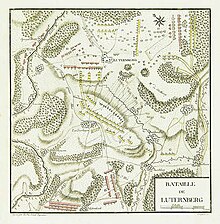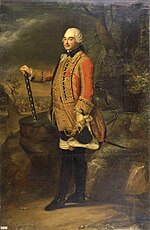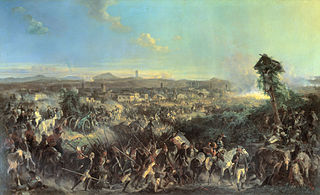
The Battle of Novi saw a combined army of the Habsburg monarchy and Imperial Russians under Field Marshal Alexander Suvorov attack a Republican French army under General Barthélemy Catherine Joubert. As soon as Joubert fell during the battle, Jean Victor Marie Moreau immediately took overall command of the French forces. After a prolonged and bloody struggle, the Austro-Russians broke through the French defenses and drove their enemies into a disorderly retreat, while French division commanders Catherine-Dominique de Pérignon and Emmanuel Grouchy were captured. Novi Ligure is in the province of Piedmont in Northern Italy a distance of 58 kilometres (36 mi) north of Genoa. The battle occurred during the War of the Second Coalition which was part of the French Revolutionary Wars.
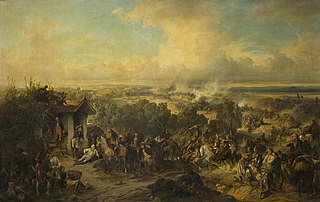
The Battle of (the) Trebbia was fought near the rivers of Tidone, Trebbia, and Nure in northern Italy between the joint Russian and Habsburg army under Alexander Suvorov and the Republican French army of Étienne-Jacques-Joseph-Alexandre Macdonald. Though French forces were moderately more numerous, the Austro-Russians severely defeated the French, sustaining about 5,500 casualties while inflicting losses of 16,500 on their enemies. The War of the Second Coalition engagement occurred west of Piacenza, a city located 70 kilometres (43 mi) southeast of Milan.

The Battle of Rossbach took place on 5 November 1757 during the Third Silesian War near the village of Rossbach (Roßbach), in the Electorate of Saxony. It is sometimes called the Battle of, or at, Reichardtswerben, after a different nearby town. In this 90-minute battle, Frederick the Great, king of Prussia, defeated an Allied army composed of French forces augmented by a contingent of the Reichsarmee of the Holy Roman Empire. The French and Imperial army included 41,110 men, opposing a considerably smaller Prussian force of 22,000. Despite overwhelming odds, Frederick managed to defeat the Imperials and the French.
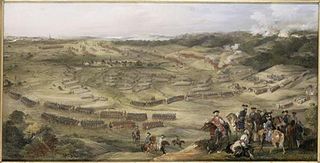
The Battle of Hastenbeck was fought as part of the Invasion of Hanover during the Seven Years' War between the allied forces of Hanover, Hesse-Kassel and Brunswick, and the French. The allies were defeated by the French army near Hamelin in the Electorate of Hanover.
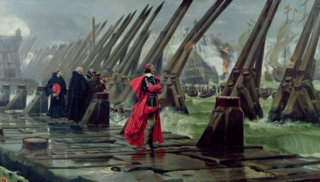
The Siege of La Rochelle was a result of a war between the French royal forces of Louis XIII of France and the Huguenots of La Rochelle in 1627–1628. The siege marked the height of the struggle between the Catholics and the Protestants in France, and ended with a complete victory for King Louis XIII and the Catholics.

The Battle of Cassano was fought in 1799 from 27 to 28 April near Cassano d'Adda, which about 28 km (17 mi) ENE of Milan. The clash is part of the battle of the Adda River or the so-called forcing of the Adda, which on the first day of 26 April resulted in a minor victory for the Russians under the Count Suvorov over Barthélemy Schérer's French forces at Lecco. Then, on the second day, Suvorov's Austrians and Cossacks prevailed over Jean Moreau's army, who replaced Schérer as supreme commander, and trapped his isolated division on the third. The action took place during the War of the Second Coalition, as part of the larger conflict known as the French Revolutionary Wars.

The Battle of Minorca was a naval battle between French and British fleets. It was the opening sea battle of the Seven Years' War in the European theatre. Shortly after the war began British and French squadrons met off the Mediterranean island of Minorca. The French won the battle. The subsequent decision by the British to withdraw to Gibraltar handed France a strategic victory and led directly to the Fall of Minorca.

The Battle of Villinghausen, took place during the Seven Years' War fought on the 15th and 16 July 1761 in the western area of present-day Germany, between a large French army and an Anglo-German force led by Prince Ferdinand of Brunswick.

In the Second Battle of Lutterberg, the Franco-Saxon contingent under General the Comte de Lusace were defeated by Prince Ferdinand.

The Battle of Wilhelmsthal was fought on 24 June 1762 during the Seven Years' War between the allied forces of Britain, Prussia, Hanover, Brunswick and Hesse under the command of the Duke of Brunswick against France. Once again, the French threatened Hanover, so the Allies manoeuvered around the French, surrounded the invasion force, and forced them to retreat. It was the last major action fought by Brunswick's force before the Peace of Paris brought an end to the war.

The Battle of Corbach, or Korbach, a Hanseatic town of Waldeck-Frankenberg in northern Hesse, Germany, was fought on 10 July 1760 during the Seven Years' War. Corbach was the first battle of the campaign of 1760 and was a victory for the French over the Hanoverians, the British and their allies.

The Third Silesian War was a war between Prussia and Austria that lasted from 1756 to 1763 and confirmed Prussia's control of the region of Silesia. The war was fought mainly in Silesia, Bohemia and Upper Saxony and formed one theatre of the Seven Years' War. It was the last of three Silesian Wars fought between Frederick the Great's Prussia and Maria Theresa's Austria in the mid-18th century, all three of which ended in Prussian control of Silesia.
The Battle of Rheinberg took place on 12 June 1758 in Rheinberg, Germany during the Seven Years' War. A French force under the command of Comte de Clermont and an Anglo-German force under the command of the Duke of Brunswick fought a largely indecisive battle. It was a precursor to the more decisive Battle of Krefeld nine days later.

The Recovery of Ré Island was accomplished by the army of Louis XIII in September 1625, against the troops of the Protestant admiral Soubise and the Huguenot forces of La Rochelle, who had been occupying the Island of Ré since February 1625 as part of the Huguenot rebellions.

The Huguenot rebellions, sometimes called the Rohan Wars after the Huguenot leader Henri de Rohan, were a series of rebellions of the 1620s in which French Calvinist Protestants (Huguenots), mainly located in southwestern France, revolted against royal authority. The uprising occurred a decade after the death of Henry IV who, himself originally a Huguenot before converting to Catholicism, had protected Protestants through the Edict of Nantes. His successor Louis XIII, under the regency of his Italian Catholic mother Marie de' Medici, became more intolerant of Protestantism. The Huguenots responded by establishing independent political and military structures, establishing diplomatic contacts with foreign powers, and openly revolting against central power. The Huguenot rebellions came after two decades of internal peace under Henry IV, following the intermittent French Wars of Religion of 1562–1598.

The Relief of Thionville took place on 7 June 1639, during the Thirty Years' War.

The Battle of Wijnendale took place during the War of the Spanish Succession fought on 28 September 1708 near Wijnendale, Flanders, between an allied force protecting a convoy carrying ammunition for the Siege of Lille (1708) and forces of Bourbon France and Spain. It ended in a victory for the allies, leading to the taking of Lille.

The Battle of the Black Mountain was fought from 17 to 20 November 1794 between the army of the First French Republic and the allied armies of the Kingdom of Spain and the Kingdom of Portugal. The French, led by Jacques François Dugommier defeated the Allies, who were commanded by Luis Firmín de Carvajal, Conde de la Unión. Though the Spanish right wing held, its left flank was driven back on the first day's fighting. On the last day of the battle, the French overran a key position and put the Spanish army to rout.
The siege of Salses (1639–1640) was a double siege during the Franco-Spanish War (1635–1659), starting with a French success, but ending with a Spanish victory.
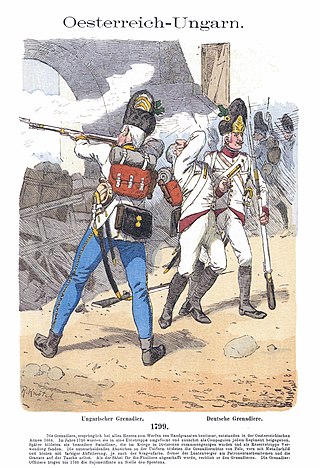
The First Battle of Marengo or Battle of San Giuliano saw Republican French soldiers under General of Division Jean Victor Marie Moreau launch a reconnaissance in force against a larger force of Habsburg Austrian and Imperial Russian troops led by Field Marshal Alexander Suvorov. The French enjoyed initial success, pressing back their opponents. However, large Austrian and Russian reinforcements soon arrived, causing the French to withdraw into Alessandria. This War of the Second Coalition meeting engagement occurred near the town of Spinetta Marengo, located just east of Alessandria in northwest Italy.
